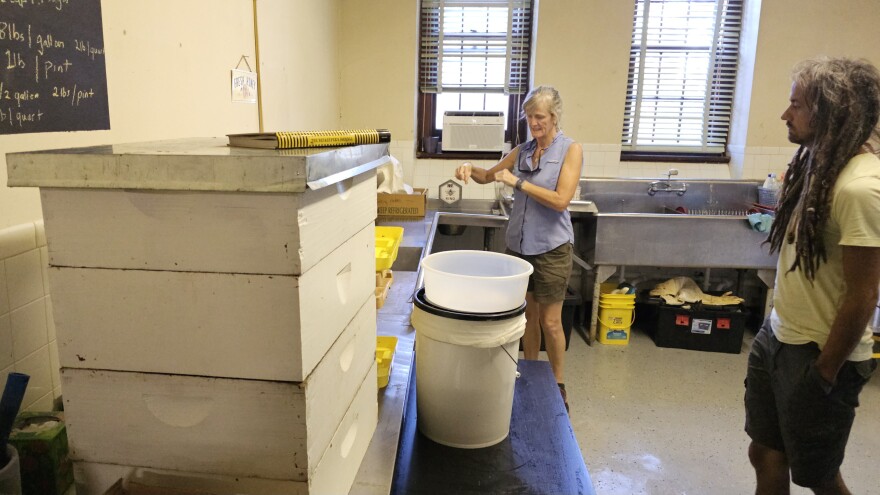Growing Urban Farmers program talks beekeeping for fun, profit

On Thursday, North Little Rock's St. Joseph Farmstead held its first workshops of the newly-created Growing Urban Farmers program.
A field day educated participants on both beginning beekeeping and how to better attract and protect pollinators to the field.
Ruth Landers is both a Central Arkansas Master Naturalist and a Pulaski County Master Gardener with years of experience as an apiarist. She says that there is some front-end investment required to begin beekeeping. Getting started can cost between $700 and $1,200 to purchase the hives, bees, and specialized tools.
Landers says it's best to begin with two hives. That way, you can compare and contrast their progress and monitor for potential diseases. If desired, you can scale up from there.

Another important part of beginner beekeeping is registration. There are limits to how many hives a region can support, and bees can travel as much as three miles in any direction from the hive.
"What's important is for them to know where all the hives are. I'm not sure that they are all registered, but they should be," said Landers. "If you were to have a serious disease like foulbrood, every hive in the area within so many miles would need to be notified, and then the inspector would need to come out and be inspecting the hives."
Safety is also a big consideration. While the number of people with severe bee sting allergies is low, you can experience a first allergic reaction following any sting. Landers says she always keeps an EpiPen on hand and commits to wearing protective gear, among other safe practices.
"I've been stung 20, 30 times at once. It's worth taking the precautions because I actually enjoy beekeeping, so I would rather be able to stay in it, so I would rather protect myself."
If you are interested in beginning beekeeping, a good place to start is to connect with local beekeeping associations and online resources.
Honeybees are not native to the Americas, as they came over with European colonizers. However, as the name suggests, they are the only species that create the honey eaten in communities around the world. Honeybees are also far more social than most native bee species and serve a different purpose to the farm.

Urban farmers and backyard gardeners who do not want to commit to beekeeping can instead select plants and flowers specifically to attract more pollinators and native bees.
Holly Anderson, Urban Conservationist with Pulaski Conservation District and Co-Chair of the Outreach and Education Subcommittee of the Arkansas Monarch Conservation Partnership, led a workshop focused on native planting, companion planting, and attracting pollinators to garden spaces.
She says intentionally increasing pollinator traffic in small-scale farms is a no-brainer; research indicates the practice can increase yields by up to 25%, and may even increase vegetable flavor and texture.
"They are an integral part of a healthy ecosystem. When you have a healthy ecosystem, you don't have to work as hard at what you're doing, and you don't have to depend as much on artificial fertilizers, herbicides, pesticides," said Anderson.
A healthy ecosystem means attracting predatory insects that feed on pests as well.

Anderson breaks down the method for attracting beneficial insects into four categories: providing food, water, shelter, and safety.
Placing native regional plants in and around the garden is a great way to bring in the beneficial insects, but timing is also critical.
"It's very important to achieve three seasons of bloom. When you're thinking of vegetable gardening particularly, you want some native plants or other plants that bloom very early in the season so you attract those pollinators to your vegetable garden early, and then you want to keep them there."
In addition to a staggered bloom, insects will also need a source of water. This can be achieved with shallow dishes filled with water and interspersed with rocks, or through small areas of the garden that are bare that can allow for shallow pooling.
You can provide shelter and safety for the insects by providing bare spots for native bees to nest inside the ground. Leaving older wood or crafting bee hotels is also a great way to encourage native bees to stay in a garden, though Anderson cautions against many commercial or ornamental bee hotels that may be more decorative than functional.

Anderson says that the biggest challenge to creating these thriving ecosystems can be sourcing native plants, which until recently were not as valued due to their lack of ornamental appeal.
The Arkansas Native Plant Society maintains a list of regional growers that supply native plants and seeds for our region.
These and upcoming workshops available as part of the Growing Urban Farmers program at the St. Joseph Farmstead are free and open to the public.
The next upcoming field day focuses on how to sell small-scale farmed goods to schools and will be held on Wednesday, July 24.
You can find more information and register for a workshop by visiting GrowingUrbanFarmers.org/Training.